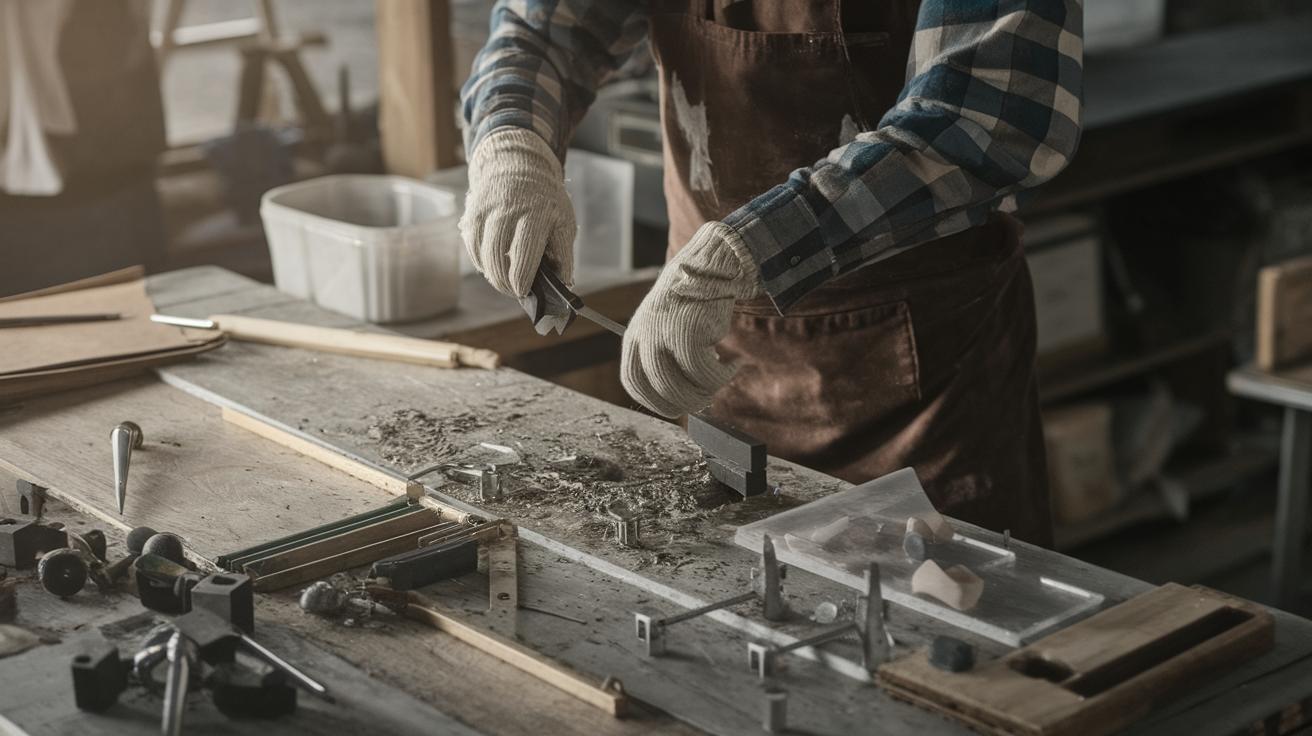Metal casting is an essential process in manufacturing, providing the backbone for creating diverse metal components ranging from everyday items to large industrial machinery. This blog post offers an in-depth guide to understanding the crucial steps in the metal casting process, examining its applications, various methods, and materials involved. Through this guide, beginners will gain comprehensive knowledge about metal casting, as well as insights into learning opportunities at The Crucible. We will also address common queries related to metal casting, and provide further resources for those looking to delve deeper into the subject. Whether you are looking to cast metal at a novice level or refine your skills, this post is designed to inspire and instruct you on your metal casting journey.
Beginners Guide to Metal Casting
Metal casting is a fascinating process that involves transforming metal into a desired shape or form by melting it and pouring it into a mold. This age-old technique has evolved significantly over thousands of years, enabling the production of everything from small art pieces to massive industrial components. It is a versatile method, capable of handling various metal types and producing intricate shapes that other manufacturing processes might struggle with.
For beginners interested in metalworking, understanding the fundamentals of metal casting is vital. It provides both a theoretical understanding and a practical skill set that is applicable across industries and artistic endeavors alike. With the right knowledge and tools, anyone can begin experimenting with metal casting and create their own metalworks.
What is metal casting?
Metal casting is the process of pouring molten metal into a mold to create a solidified object. The molten metal cools and hardens within the mold, taking on its shape, which is then extracted to form the end product. This process allows for the creation of complex geometries and is a cornerstone in the manufacturing of metals.
The history of metal casting dates back over 5,000 years, playing a pivotal role in human civilization’s development. It remains indispensable today, utilized across various sectors such as automotive, aerospace, art, and construction, demonstrating the technique’s enduring relevance and utility.
What is metal casting used for?
The applications of metal casting are numerous and span many industries. In the automotive industry, components like engine blocks and transmission cases are produced using casting methods. In aerospace, metal casting manufactures critical parts like jet engine components, which are designed to withstand extreme conditions.
Beyond industrial applications, metal casting is also prevalent in art and jewelry, where artisans use metal casting to bring creative designs to life. The process’s ability to reproduce detailed and complex structures makes it ideal for intricate artistic works and decorative pieces.
Different types of metal casting
Expendable mold casting
Expendable mold casting involves using a single-use mold made from materials like sand, plaster, or lost foam. The mold is destroyed during the casting process after the metal has cooled and solidified, hence the term “expendable.” This method is versatile, allowing for the production of a wide range of sizes and shapes.
Sand casting, a type of expendable mold casting, is one of the oldest and most commonly used methods. It involves creating a sand mold around a pattern, which is then filled with molten metal. The sand mold’s ability to withstand high temperatures and its ease of use make it a favorite for many metal casters.
Non-expendable mold casting
Non-expendable mold casting uses molds that withstand multiple castings, typically made from materials that resist high temperatures like metal and graphite. This method is often used for high-volume manufacturing, as the durability of the molds can lead to cost savings over time.
Investment casting, also known as lost wax casting, is a popular form of non-expendable mold casting. It involves coating a wax or plastic pattern with a refractory material to form a shell. Once the shell is complete and the pattern is removed, molten metal is poured into the cavity to create the final piece. This method is renowned for producing highly accurate and detailed castings.
The basic metal casting process
Step 1: Create the pattern
The first step in the metal casting process is creating a pattern used to shape the mold. The pattern is a prototype of the final product and can be made from wood, plastic, or metal. It must be carefully crafted to ensure precision and accuracy in the final casting.
This step might involve creating sub-patterns for complex parts that will later be assembled. The pattern is integral to the success of the casting, as it determines the mold’s shape and ultimately, the finished metal object.
Step 2: Make the mold
Once the pattern is ready, the next step is to create the mold. Depending on the casting method being used, this could involve packing sand around the pattern or applying layers of refractory material in the case of investment casting. The mold creates the cavity into which the molten metal is poured.
Attention to detail is crucial during mold-making to ensure the final casting has the desired finish and dimensions. The mold must accommodate the metal’s expansion and contraction during cooling and solidification.
Step 3: Choose the metallic alloy
Choosing the right metallic alloy is critical in casting, as it affects the mechanical properties, corrosion resistance, and overall performance of the final product. Common alloys used in casting include aluminum, bronze, cast iron, and steel.
The choice of alloy is determined by the intended application and the specific properties required from the casting. For instance, aluminum is valued for its lightweight and corrosion-resistant qualities, making it ideal for automotive and aerospace applications.
Step 4: Melt the alloy
Once an alloy is selected, the next step is melting it down to a liquid state suitable for pouring into the mold. This requires specialized equipment such as a furnace capable of reaching and maintaining the necessary temperatures specific to the alloy in use.
Safety is paramount during this step, as handling molten metal involves significant risks. Proper protective equipment and adherence to safety protocols are essential when melting and pouring metals.
Step 5: Pour into the mold
With the alloy melted, it is carefully poured into the mold. Ensuring a steady and controlled pour is vital to avoid defects and ensure the even filling of the mold cavity. This step demands precision and skill, as the metal must fill every part of the mold without air pockets or voids.
Often, gating systems are employed to facilitate the efficient flow of molten metal into the mold, helping minimize the potential for casting defects that can occur during this process.
Step 6: Remove the casting from the mold
After the metal has been poured and allowed to cool, the casting is removed from the mold. The method of removal depends on the type of mold used; in expendable mold casting, the mold is broken away, whereas non-expendable molds may open on hinges.
This step must be done delicately and with care to ensure that the casting isn’t damaged during the extraction process, maintaining its shape and surface integrity.
Step 7: Finishing
The final step in the casting process is finishing, which involves cleaning up the casting, removing any excess metal (such as gates and risers), and polishing the surface. This step enhances the appearance and functionality of the metal part.
Depending on the requirements, additional finishing processes like machining, heat treatment, or coating may be performed to achieve the desired surface finish and mechanical properties.
Learning how to cast metal
For individuals interested in learning metal casting, numerous resources and institutions offer classes and workshops. The Crucible is one such organization where beginners to advanced artisans can explore metal casting techniques through hands-on training and expert guidance.
Participating in structured courses provides learners with the opportunity to understand theoretical concepts while gaining practical skills in a controlled environment. These courses often cover various aspects of metal casting, from pattern making to mold creation and finishing techniques.
Learn metal casting at The Crucible
The Crucible, renowned for its comprehensive metal arts education, offers diverse classes for those eager to learn metal casting. Their curriculum spans foundational courses to advanced workshops, suitable for people at different skill levels looking to explore metalworking and casting.
With experienced instructors and state-of-the-art facilities, The Crucible ensures students gain valuable hands-on experience, whether their interest lies in practical metal applications or creative artistic expression. Engaging in these courses fosters a deeper understanding of metal casting’s possibilities.
Metal casting FAQs
Can I cast metal at home?
While metal casting is generally an industrial process, it is possible to perform small-scale metal casting at home with the proper equipment and safety measures. Hobbyists often begin with low-melting-point metals like pewter or lead, which require less specialized equipment compared to high-melting-point metals.
However, it’s important to prioritize safety due to the hazards associated with molten metal and high temperatures. Adequate ventilation, protective gear, and an understanding of the casting process are crucial for safe home-based metal casting activities.
What are the different types of metal casting?
As discussed, metal casting can be broadly categorized into expendable mold casting and non-expendable mold casting. Within these categories lie methods such as sand casting, investment casting, die casting, and more. Each type has its own advantages, limitations, and specific applications.
The choice of casting method usually depends on factors such as the metal being used, the complexity of the part, production volume, and cost considerations. Understanding these differences helps in selecting the appropriate method for particular casting projects.
What tools do you need to cast metal?
The tools required for metal casting vary based on the scale and method of casting. At the most fundamental level, essential tools include a furnace for melting metal, molds, tongs or ladles for handling molten metal, and equipment for creating patterns and molds.
In addition, safety gear such as heat-resistant gloves, face shields, aprons, and proper ventilation systems are imperative to ensure the safety of individuals involved in the casting process, especially in a home setting.
What metals are easiest to cast?
Metals with lower melting points, such as aluminum, pewter, lead, and tin, are generally easier to cast, making them ideal for beginners. These metals require lower temperatures to melt, which means less energy consumption and simpler equipment like a basic home furnace.
Aluminum, in particular, is a popular choice due to its lightweight nature, corrosion resistance, and relatively low melting point. It can be handled in various casting environments with less risk than other more refractory metals like steel.
How do you make a mold for casting metal?
Creating a mold for casting involves shaping a cavity around a pattern that mimics the final part’s geometry. In expendable mold casting, materials like sand or plaster are packed around the pattern. Molds are prepared by applying pressure or adhesives to bind the material.
Non-expendable molds involve coating a pattern with refractory material in the investment casting process. Precision is key in making molds to ensure the final casting achieves the desired dimensions and surface finish.
Continue Exploring Guides In Metal
If you’re passionate about exploring metalworking further, here are some additional resources to expand your knowledge and skills. These guides provide insights into specialized areas of metalworking and casting, encouraging a deeper exploration of the craft.
Power Hammers 101: How To Use a Power Hammer
Power hammers are invaluable tools in modern metalworking, offering the ability to shape metal with force and precision. This guide explains the setup, operation, and maintenance of power hammers, illuminating their role in forging and shaping metalwork.
Foundries 101: What Is A Foundry? What Foundry Workers Do?
Foundries are the industrial powerhouses where metal casting occurs on a large scale. Understanding the operations of a foundry and the roles within offers valuable insights into the process and scale of industrial metal casting.
Bronze Casting 101: Process of Casting Bronze [+How To Learn]
Bronze is a classical metal with significant historical importance in casting. This guide delves into the methods of bronze casting, offering techniques and tips for creating bronze art and objects, highlighting this metal’s enduring allure.
Lost Wax Casting Guide
Delve into the art of lost wax casting, a method revered for creating detailed and precise metal artifacts. This guide explores the steps involved in creating a mold, casting metal, and finishing techniques unique to lost wax casting.
16 Blacksmithing Techniques
Blacksmithing offers a blend of artistry and technical precision. This comprehensive guide introduces 16 essential blacksmithing techniques, ideal for both beginners and seasoned artisans seeking to refine their metalworking skills and artistry.
You Can Learn To Cast Metal
The Crucible has new metal casting classes offered weekly.
At The Crucible, individuals can immerse themselves in the art and science of metal casting through weekly classes and workshops. These classes cater to a diverse range of interests, from jewelry making to advanced metalwork.
3-Hour Taster: Jewelry
This three-hour class provides an introduction to jewelry making, allowing students to explore metal casting techniques in creating unique, personalized jewelry pieces.
Jewelry and Metals I
An immersive course for those looking to delve deeper into jewelry making, covering foundational techniques, tools, and materials essential for crafting beautiful metal jewelry.
Exploration in Chainmaking
Participants will explore the intricate world of chainmaking, learning various link styles and techniques to create stunning chain jewelry that blends aesthetics with function.
Casting Wax to Silver
This course offers an introduction to casting wax models into silver pieces, teaching students about modeling, mold making, and the intricate process of transforming wax designs into precious metal art.
Jewelry Lab
The Jewelry Lab provides an open environment for students to experiment with various jewelry-making methods, encouraging creativity and skill refinement under expert guidance.
Silver Soldering
This class focuses on mastering silver soldering techniques, an essential skill in jewelry making, allowing craftsmen to create seamless metal joints with precision and stability.
Elegant Stacking Rings
Discover the art of creating elegant stacking rings, a popular trend in jewelry. Students will learn about ring sizing, metal selection, and soldering techniques.
Jewelry and Metals II
An advanced course designed to build upon previous jewelry-making skills, focusing on complex design execution and refined metalwork techniques.
Youth Jewelry and Metals I
This class introduces young participants to the art of jewelry making, teaching basic techniques and fostering creative expression through metal art.
Metal Clay Rings
Participants learn to work with metal clay to craft unique rings, exploring molding, shaping, and firing techniques to create stunning pieces.
Youth Chibi: Miniature Figurines
This class invites young artists to create chibi-style miniature metal figurines, combining artistic storytelling with metal crafting techniques.
Youth Jewelry and Metals II
An advanced level course for young artisans eager to expand their jewelry and metalworking skills with more intricate projects and techniques.
Future Prospects
As you embark on or continue your journey in metal casting, remember that mastery is a continuous process. With resources like The Crucible and other educational guides, acquiring and refining your skills in metal casting is more accessible than ever. The vibrant world of metal art and manufacturing holds endless possibilities for those eager to pursue it. Whether your interest lies in practical applications or artistic achievements, metal casting offers a rewarding and enduring craft.
| Section | Content Summary |
|---|---|
| Beginners Guide to Metal Casting | An overview of metal casting and its relevance in various fields, highlighting its artistic and industrial applications. |
| What is metal casting? | Explains the process, its ancient origins, and its ongoing significance. |
| What is metal casting used for? | Details the wide-ranging applications from industrial components to artwork. |
| Different types of metal casting | Describes expendable and non-expendable casting methods with examples. |
| The basic metal casting process | Outlines the seven crucial steps from pattern creation to finishing. |
| Learning how to cast metal | Discusses opportunities and resources for learning metal casting skills. |
| Learn metal casting at The Crucible | Highlights offerings at The Crucible for comprehensive metal casting education. |
| Metal casting FAQs | Answers common questions regarding home casting, methods, and materials. |
| Continue Exploring Guides In Metal | Provides further reading and resources on specialized metalworking topics. |


